The best fluoride water filters completely eliminated fluoride from our water in our testing, and they also reduced dozens of other common drinking water contaminants.
We test all the water filters in our reviews and guides using our own metrics-driven assessment process.
All the filters in this guide were personally tested by Brian Campbell, an experienced WQA Certified Water Specialist (CWS) and Certified Water Treatment Representative (CWR) who has been reviewing water filters for over a decade.
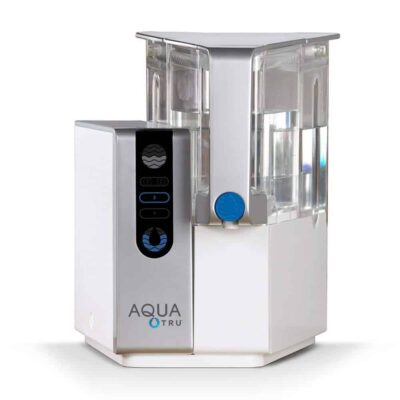
AquaTru
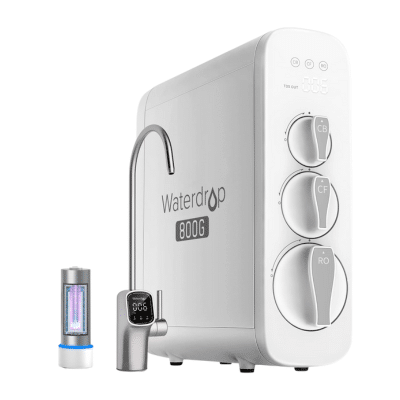
Waterdrop G3P800
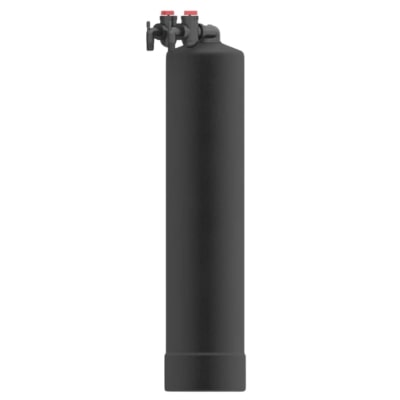
SoftPro Chlorine+ & Fluoride Filter
Table of Contents
Our Testing & Selection Process
The 7 Best Water Filters that Remove Fluoride
| Product | 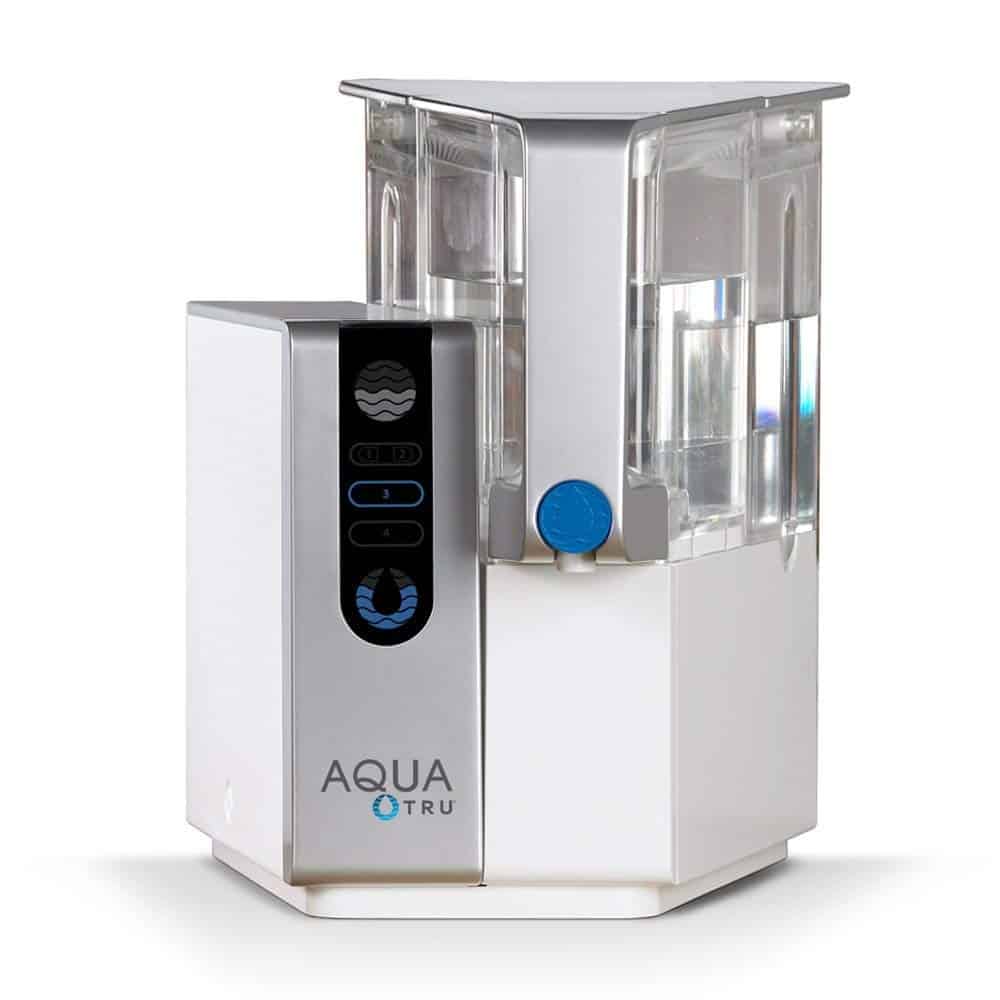 AquaTru | 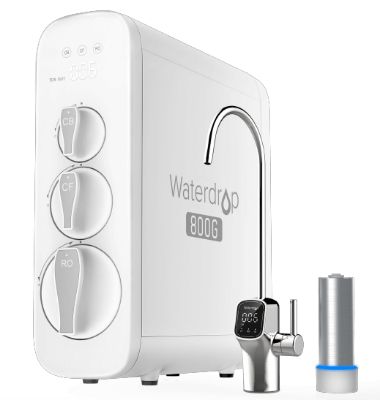 Waterdrop G3 P800 |  SoftPro | 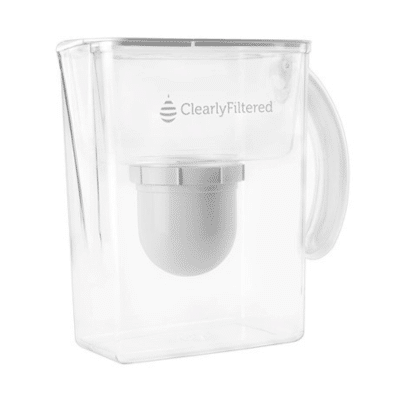 Clearly Filtered Pitcher | 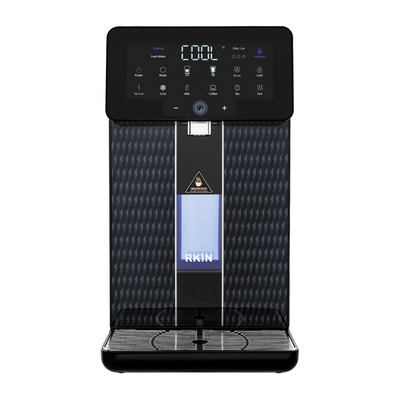 RKIN U1 | 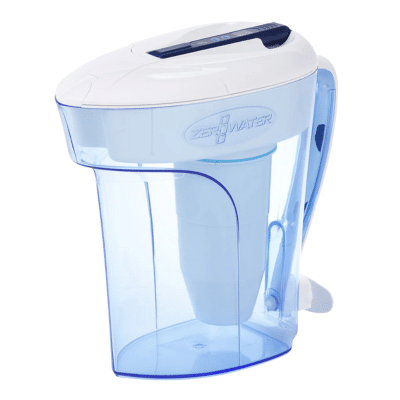 ZeroWater | 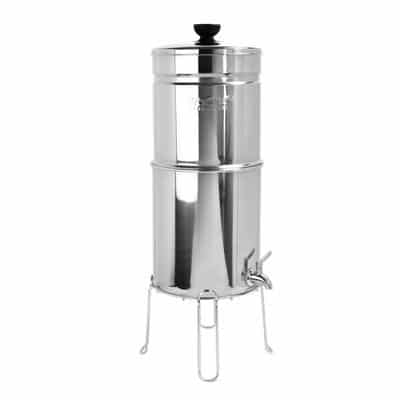 ProOne Big+ |
|---|---|---|---|---|---|---|---|
| Score | 9.54 | 9.21 | 9.13 | 8.78 | 8.86 | 8.62 | 8.56 |
| Price | $449.00+ | $539 - $999 | $900.00 | $90.00 | $749.95 | $39.99 | 229.95+ |
| Certifications | NSF/ANSI 42, 53, 58, 401, and P473 | NSF/ANSI 58, 372 | - | NSF/ANSI 42, 53 | - | NSF/ANSI 42, 53 | NSF 42 (materials safety only) |
| Filter Capacity | 600 – 1,200 gallons | 550/ 1100/ 2900 gallons | 1,000,000 gallons | 100 gallons | 792 – 1,200 gallons | 20 - 40 gallons | 1,00-1,200 gallons |
| Cost per Gallon | $0.11 | $0.11 | $0.0009 | $0.55 | $0.08 | $0.70 | $0.41 |
| Warranty | 1 year | 1 year | Limited lifetime | 2 years | 1 year | 90 days | 5 years |
| Read Review | AquaTru review | Waterdrop G3 RO review | SoftPro Chlorine+ & Fluoride Filter review | Clearly Filtered review | RKIN U1 review | ZeroWater pitcher review | ProOne Big review |
AquaTru
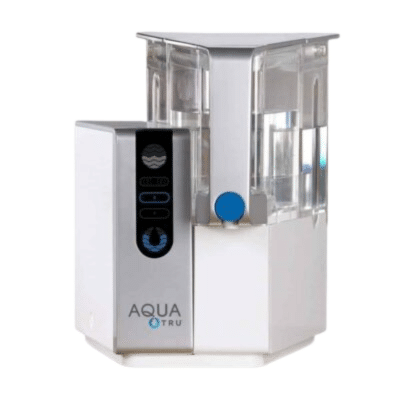
The AquaTru is a reverse osmosis countertop filtration system that purifies water and eliminates 100% fluoride, as well as dozens of other contaminants. In our testing, it did the best job at reducing fluoride and all the other contaminants detected in our water, and we could enjoy the benefits of RO without a difficult setup or costly maintenance.
Best For
Product Specs
| Price | $449.00+ |
| Contaminants Removed | 83+ |
| Certifications | NSF 42, 53, 58, 401, and P473 |
| Process | Mechanical + RO + Carbon |
| Filtration Capacity | 600 – 1,200 gallons |
| Annual Cost | ~$100 |
| Warranty | Lifetime |
Why It’s Best
The AquaTru is the best overall water filter for reducing fluoride because it received the highest overall score i our testing, and, of course, it reduced 100% fluoride in our water.
The system uses reverse osmosis, which is the most thorough method of water purification and targets a broad spectrum of contaminants more effectively than non-RO water filtration. 100% of all the contaminants in our water were eliminated by the AquaTru. It’s the only system we’ve tested that has a performance certification to reduce all the impurities it claims to target.
Plus, it’s the most efficient countertop RO system we’ve used.
AquaTru Performance
We awarded the AquaTru a 9.90 for its health-related contaminants reduction. In our testing, it eliminated 100% of fluoride, as well as all the other contaminants with possible health effects detected in our water: lead, uranium, strontium, molybdenum, and barium.
The system got an equally high score of 9.90 for reducing aesthetic contaminants, owing to its 100% chlorine reduction.
What really impressed us about the AquaTru is that it has been IAPMO certified to NSF Standards 42, 53, 58, 401, and P473 for the reduction of all 83 contaminants that AquaTru claims it can reduce. The system has also been certified for materials safety and has an NSF 372 certification for lead-free design.
Wastewater is a side effect of the RO process, and conventional RO systems are known for being inefficient and wasteful. The AquaTru is, by contrast, the most efficient countertop RO system we’ve tested, with a 4:1 recovery rate, meaning that only 1 gallon of water is wasted for every 4 gallons purified.
Setup and maintenance were a breeze with this unit. It’s a plug-and-play machine that arrived partially assembled, and maintenance was easy and surprisingly affordable given that we had multiple filters to replace. We awarded the AquaTru a 10.00 for setup and a 9.75 for maintenance.
We think the AquaTru just makes sense for anyone who wants to eliminate fluoride and all the other impurities in their water, using a system that has been extensively certified for its performance and design.
| Criteria | Results |
|---|---|
| Health Related Contaminants | 9.90 |
| Aesthetic Related Contaminants | 9.90 |
| Performance Certification | Certified for 100% of reduction claims |
| Filtration Rate | 0.04f GPM |
| Component Quality | Outstanding |
| Component Certification | Exceptional |
| Setup | Exceptional |
| Servicing Requirements | Outstanding |
| Costs | $0.11/ gallon |
| Warranty Length | 1 year |
| Shipping | Free shipping |
| Returns | 30 days |
Waterdrop G3 P800

The Waterdrop G3 P800 is an under-sink tankless reverse osmosis system that reduced or removed 10 contaminants in our water, including fluoride (removed completely) lead, arsenic, and nitrate. The unit purifies water on demand and uses a dedicated faucet at your kitchen sink.
Best For
Product Specs
| Price | $539 – $999 |
| Contaminants Removed | 1,000+ |
| Certifications | NSF/ANSI 58, 372 |
| Process | RO |
| Filtration Capacity | 550/ 1100/ 2900 gallons |
| Annual Cost | ~$145 |
| Warranty | 1 year |
Our Verdict
The Waterdrop G3 P800 is our top recommended under-sink reverse osmosis system for reducing fluoride because it got the second-best overall score of all the filters we reviewed, and it completely eliminated fluoride from our water.
The system’s 3:1 pure-to-wastewater ratio means it’s almost as efficient as the AquaTru, and its lack of a water storage tank meant it was easier to install (than tank-based systems) in the cupboard beneath our sink without taking up too much room.
It also has a great filtration rate of 800 gallons per day (GPD), which is one of the fastest we’ve seen for an under-sink RO system.
Waterdrop G3 P800 Performance
The Waterdrop G3 P800 received a 9.20 score for contaminant reduction. Our test data showed that it eliminated 100% fluoride, chlorine, arsenic, chloride, copper, lead, manganese, potassium, and selenium in our water.
It also reduced 90% nitrate, 88% barium, 87% calcium, magnesium, and strontium, and 82% sodium.
We were also pleased to see that the system has been IAPMO certified to NSF 42, NSF 58, and NSF 53, for reducing fluoride, chlorine, TDS, cadmium, hexavalent chromium, and selenium. Its certifications aren’t as extensive as AquaTru’s, though.
The G3 P800 secured a 9.70 for design. It’s a smart system, with TDS meters on the faucet and unit body for monitoring the performance of the filters, a built-in filter life tracker, and a UV purifier to protect against recontamination of the filtered water leaving the unit. It’s only missing a built-in remineralization filter – Waterdrop sells one separately at an extra cost.
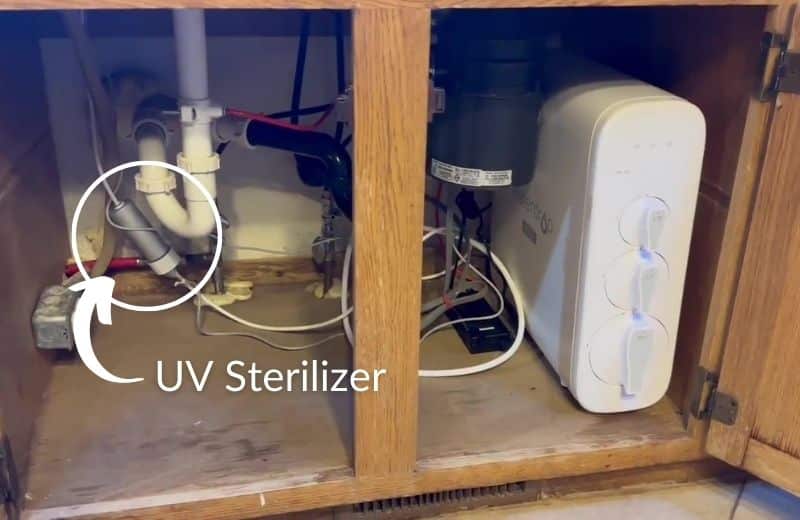
Setup was trickier with this Waterdrop system, and its 7.00 score in this category reflects the challenges we faced when installing it underneath our sink.
Installing the system took us around 1 hour 30 minutes, and connecting the pipes and drilling a hole for the RO wastewater line required some hands-on DIY work. But once the system was installed, maintenance was easy – we awarded the G3 P800 a 10.00 score because the filters were easy to change and had a low ongoing cost of just $0.11/ gallon.
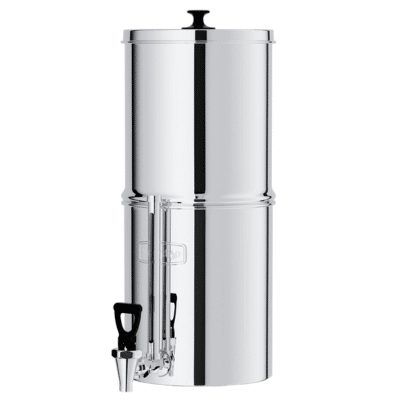
Waterdrop King Tank
Another great offering by Waterdrop is the King Tank, a stainless steel gravity-fed countertop water filtration system, which also reduced 100% fluoride in our testing (it has dedicated fluoride filters for this purpose). Plus, the unit reduced 100% manganese, 93% copper, 40% barium, and more. It’s a more affordable alternative to RO and doesn’t waste water.
We recommend the Waterdrop G3 P800 to folks who want a certified, reliable, and highly effective means of removing fluoride and many other impurities from their water supply, with the benefit of filtered water on demand from your kitchen faucet.
| Criteria | Results |
|---|---|
| Health Related Contaminants | 9.50 |
| Aesthetic Related Contaminants | 3.50 |
| Performance Certification | Certified for 100% of reduction claims |
| Filtration Rate | 600 or 800 GPD |
| Component Quality | Outstanding |
| Component Certification | Certified |
| Setup | Weak |
| Servicing Requirements | Exceptional |
| Costs | $0.11/ gallon (w/o remineralization), $0.13/ gallon (w/ remineralization) |
| Company | Good |
SoftPro Chlorine+ & Fluoride Filter

The SoftPro Chlorine+ & Fluoride Filter is a POE water filtration system that uses two types of carbon media to filter fluoride out of your entire home’s water supply. This system got the third-highest overall score of all the filters in this list, and its use of bone char carbon gives it the unique ability to reduce fluoride – something we rarely see with whole-house systems.
Best For
Product Specs
| Price | $900.00 |
| Contaminants Reduced | 10+ |
| Certifications | Not certified for any reduction claims |
| Process | Catalytic + Bone Char Carbon |
| Filter Capacity | 1,000,000 gallons |
| Annual Cost | ~$40 |
| Warranty | Lifetime |
Our Thoughts
The SoftPro Chlorine+ & Fluoride Filter is the only whole-house water filtration system we’ve tested so far that effectively reduces fluoride. In fact, it did a great job overall at reducing the contaminants in our water, securing the second-highest score for this area of its performance.
The system has an impressively high maximum flow rate of 14 GPM, and we saw no difference in our water pressure after installing it at our POE.
Plus, because it’s a tank-based system with a long media lifespan, it doesn’t require filter cartridge changes, making it the easiest system to maintain of all the filters on this list.
SoftPro Chlorine+ & Fluoride Filter Performance
The SoftPro Chlorine+ & Fluoride Filter obtained a 9.42 score – second to the AquaTru – for contaminant reduction. In our testing, it reduced 100% fluoride, as well as 100% of the two disinfection byproducts, zinc, aluminum, nickel, chlorine, and strontium that were detected in our feed water.
Copper was also reduced by 97%, we used a separate PFAS test that showed the system completely eliminated MeFBSA.
The only letdown here? The Chlorine+ system isn’t performance-certified, so it’s missing that reliable third-party proof of performance from an official organization.
The system received an 8.40 score for design – it’s our preferred configuration as a tank-based system and scored a 10.00 for its component quality. We noted that it feels durable and solid, but its lack of a materials safety certification prevented it from getting the highest overall score here.
We found setup challenging, as is the case with all systems that need to be installed at the POE. The manual states that a professional installation is recommended, but if you’re a handy person, you should be able to install it yourself. The SoftPro unit received a 7.00 score for installation.
The silver lining was that once the system had been installed, it was essentially maintenance-free, so it redeemed itself in this category with a 9.75 overall score. The media only needs replacing after filtering 1 million gallons of water, or after 6-10 years of use, and we calculated the system’s ongoing spend as just $0.0009/ gallon – the most affordable on this list by far.
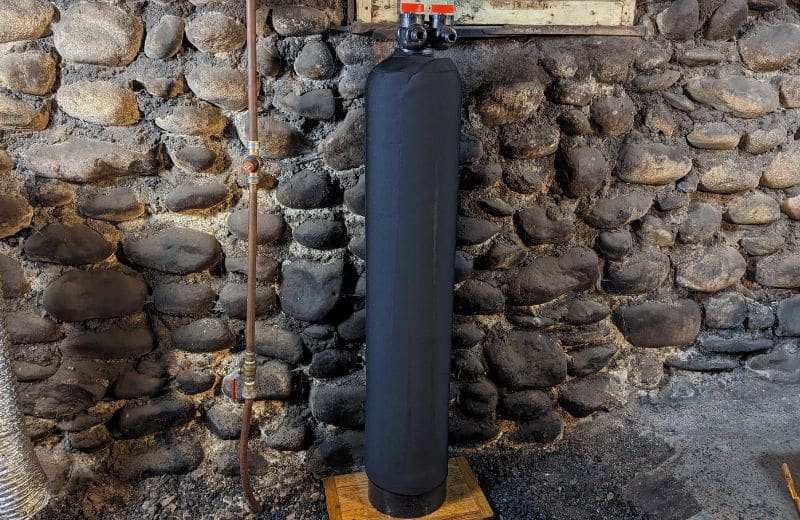
We think the SoftPro Chlorine+ filtration system is the obvious choice for folks who want to remove fluoride and other common contaminants from their entire home’s water supply, and are happy to invest more upfront in the system with the most affordable maintenance.
| Criteria | Results |
|---|---|
| Health Related Contaminants | 9.80 |
| Aesthetic Related Contaminants | 9.90 |
| Performance Certification | Not certified for any reduction claims |
| Filtration Rate | 14 GPM |
| Component Quality | Exceptional |
| Component Certification | Not certified |
| Setup | Weak |
| Servicing Requirements | Outstanding |
| Costs | $0.0009/ gallon |
| Warranty Length | Limited lifetime |
| Shipping | Free on orders over $75 |
| Returns | Failing |
Clearly Filtered Water Pitcher

The Clearly Filtered Water Pitcher is a gravity-fed filter that reduced 100% fluoride and most of the other contaminants in our water. It was one of the few water filter pitchers we tested that could reduce fluoride.
Best For
Product Specs
| Price | $90.00 |
| Contaminants Reduced | 365+ |
| Certifications | NSF 42, 53 |
| Process | 10 Cups |
| Filter Capacity | 100 gallons |
| Annual Cost | $150 |
| Warranty | 2 years |
Why We Like It
The Clearly Filtered Water Pitcher is the best fluoride-reducing water filter pitcher for folks who prefer a system that can be set up quickly and in any location, and has just one filter to replace.
Its superior contaminant reduction abilities put it at the top of our list for reducing fluoride and many other impurities, like uranium and copper. Its 100-gallon filter life is shorter than many RO filters we tested, but better than the average 40-gallon lifespan that most pitcher filters have.
We set the system up and had it ready to use in a matter of minutes, and unlike the RO systems we reviewed, the CF pitcher doesn’t waste water.
Clearly Filtered Performance
We gave the Clearly Filtered pitcher a score of 8.24 for contaminant reduction. As well as reducing 100% fluoride, it also eliminated uranium, chlorine, and copper, and reduced 86% barium, 67% strontium, 53% molybdenum, and 11% nitrate.
However, 0.0054 PPM of cobalt appeared in our filtered water, which reduced its score slightly in this category.
Clearly Filtered’s WQA performance certifications (to NSF/ANSI Standard 42 and Standard 53, for the reduction of chlorine, PFOA, and PFOS) are reassuring, although again, it doesn’t quite compare to AquaTru because it’s only certified to reduce 3 out of the 365+ contaminants it’s claimed to reduce. Also, it isn’t certified for fluoride reduction, which is disappointing.
Although the CF pitcher has a more basic design than the RO systems we tested, it got one of the highest scores of all the pitchers in its category: 9.70. We noted that the pitcher’s BPA-free Tritan plastic design felt thicker, sturdier, and better-made than most of its competitors, and we were pleased to see that it’s certified both for materials safety and for lead-free design.
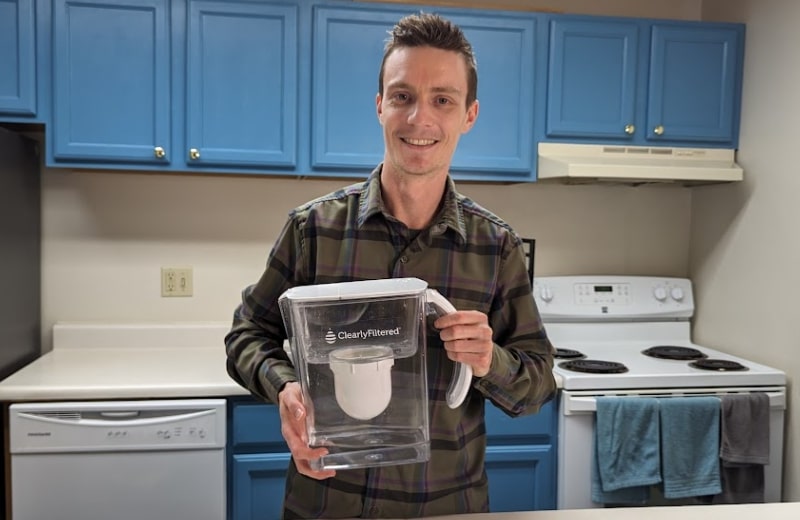
In our testing, the pitcher filtered 0.5 gallons of water in 13 minutes and 12 seconds, giving it a filtration rate of 2.27 GPH.
We think the Clearly Filtered Pitcher is the best fluoride filter for people who don’t want the commitment of an expensive machine and prefer the simplicity and portability of one of the best-performing water filter pitchers.
| Criteria | Results |
|---|---|
| Health Related Contaminants | 83 |
| Aesthetic Related Contaminants | 99 |
| Performance Certification | Certified for 0.82% of reduction claims |
| Filtration Rate | 2.27 GPH |
| Component Quality | Outstanding |
| Component Certification | Certified |
| Setup | Outstanding |
| Servicing Requirements | Outstanding |
| Costs | $0.55/ gallon |
| Warranty Length | 2 years |
| Shipping | Free shipping all orders |
| Returns | 30 days |
RKIN U1

The RKIN U1 is a modern, sophisticated countertop reverse osmosis system that eliminated fluoride and reduced up to 100% of all other contaminants detected in our water. It’s one of the most high-tech and unique systems we’ve tested and can dispense hot or cold purified water with the press of a button.
Best For
Product Specs
| Price | $749.95 |
| Contaminants Removed | 99% of most contaminants |
| Certifications | NSF 58 (in progress) |
| Process | Mechanical + Carbon + RO + Alkaline + Hydrogen infusion |
| Filtration Capacity | 6, 12, 24 months |
| Annual Cost | ~$180 |
| Warranty | 1-year warranty & 1 year money-back guarantee |
Our Take
The RKIN U1 is a high-end countertop water filtration system. It has a host of unique performance features that make it the best choice for folks looking for a fluoride filter with the most benefits and functions.
It doesn’t only purify water – it also introduces healthy minerals with its built-in remineralization filter and infuses hydrogen with an additional water treatment stage.
The unit performed very similarly to AquaTru, although there were a few contaminants that it didn’t completely eliminate.
RKIN U1 Performance
In the contaminant reduction category, the RKIN U1 obtained a 9.00 score. It reduced 100% fluoride, lead, chlorine, uranium, copper, molybdenum, and zinc, and greatly reduced nitrate, barium, and sulfate.
But it doesn’t have a performance certification, which is why we didn’t recommend it as our top choice.
The system is another countertop unit, so again, we found it easy to install and maintain – we awarded it 10.00 and 9.75 scores for setup & servicing. Like the AquaTru, the U1 arrived partially installed, and it has a dedicated flush function, so we didn’t have to prime or wash the filters manually. Its cost-per-gallon of $0.0809 means that it’s super affordable to maintain, even if its upfront cost is higher than any of the other filters on this list.
We measured the U1’s filtration rate as 0.07 GPM, which was almost exactly the same as AquaTru’s (0.08 GPM).
The U1 didn’t do as well in the design category. Despite having a few impressive design features, like its sophisticated touch-screen display panel, we weren’t blown away by its component quality. We gave it a score of 7.50 because it’s mostly made from plastic and isn’t certified for materials safety.
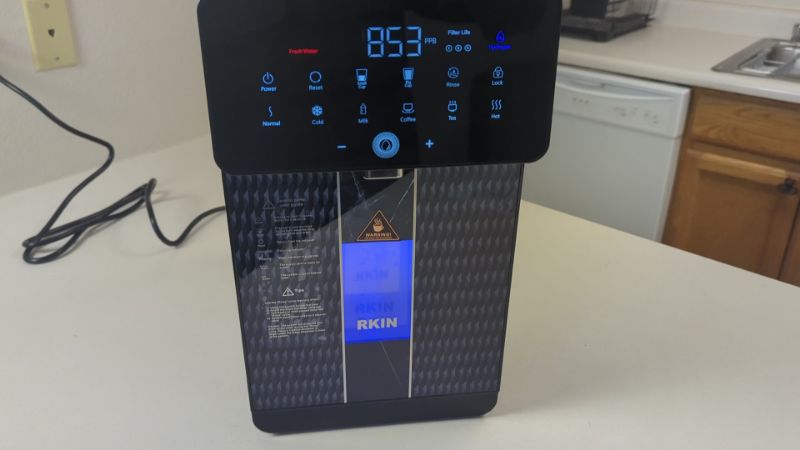
Our favorite feature of the RKIN U1 was that we could dispense hot or cold water and use the different presets to dispense purified water for different purposes. We think the U1 is a worthy investment for folks with big budgets who love to own the latest high-tech products, especially people who want to be able to easily access purified hot water.
| Criteria | Results |
|---|---|
| Health Related Contaminants | 9.30 |
| Aesthetic Related Contaminants | 9.90 |
| Performance Certification | Not certified for any reduction claims |
| Filtration Rate | 0.07 GPM |
| Component Quality | Outstanding |
| Component Certification | Not certified |
| Setup | Exceptional |
| Servicing Requirements | Exceptional |
| Costs | $0.08/gallon |
| Warranty Length | 1 year |
| Shipping | Free shipping on orders over $175 to lower 48 states |
| Returns | 30 days |
ZeroWater Pitcher

The ZeroWater Pitcher uses a unique 6-stage filter to reduce TDS down to 0 and has a more extensive range of performance certifications than the Clearly Filtered pitcher – although still not as many as AquaTru.
Best For
Product Specs
| Price | $39.99 |
| Contaminants Reduced | 24 |
| Certifications or Testing | NSF/ANSI 42, 53 |
| Holding Capacity | 12 cups |
| Filter Lifespan | 20 – 40 gallons |
| Approx. Annual Cost | ~$110 |
Our Testing Notes
The ZeroWater Pitcher is our runner-up recommendation for folks who want to reduce fluoride and other contaminants with a water filter pitcher.
It got great scores from us for its contaminant reduction, filtration rate, and setup, and it’s certified to reduce 6 contaminants. But its overall score was slightly lower than Clearly Filtered’s because it didn’t perform as well in the company, maintenance, and design categories.
The pitcher is designed to reduce TDS down to 0, and it comes with a TDS meter that you can use to track the filter’s performance (ZeroWater recommends getting a new filter when the TDS meter reads 006).
ZeroWater Performance
ZeroWater’s score for contaminant reduction was 8.34, and, like the other filters in this guide, it reduced 100% fluoride. Other contaminants that were completely eliminated were nitrate, chlorine, barium, uranium, strontium, molybdenum, and sulfate. Plus, 97% copper was reduced.
The filter did a really great job of reducing contaminants with health effects, but its score was impacted by the presence of 3.4 PPB of chloroform in our filtered water, which indicated that ZeroWater doesn’t effectively address disinfection byproducts. We also weren’t impressed with the filter reducing healthy minerals just so ZeroWater can claim TDS reduction down to 0.
It was good to see that the filter has been certified to NSF Standard 42 and Standard 53 for reducing chlorine taste and odors, PFOA, PFOS, mercury, lead, and hexavalent chromium. But it didn’t get the top score here because it doesn’t have a fluoride reduction certification, and it isn’t certified for all 24 contaminants that ZeroWater says it can reduce.
The ZeroWater pitcher is the only pitcher we’ve tested so far that requires no filter prep whatsoever. We could just wash the pitcher and reservoir, install the filter, and start using it straight away – no priming, flushing, or soaking required. We gave it a 9.50 score in this category.
We appreciated that we could use the TDS meter to determine when the filter needed changing, but the filter capacity is very low at just 40 gallons (meaning it needed replacing as often as once every 1-2 weeks). This gave it a much higher ongoing cost of $0.70/ gallon, which was almost three times the cost per gallon of its competitors.
The ZeroWater pitcher got the best score – 10.00 – for filtration rate. It has a filtration speed of 2.62 GPH, based on its ability to filter 0.391 gallons of water in just under 9 minutes, so it’s slightly quicker than Clearly Filtered.
We recommend the ZeroWater filter pitcher to folks who want an easy way to track their filter performance and are interested in reducing TDS alongside fluoride, at the expense of a higher ongoing cost and a shorter filter lifespan.
| Criteria | Results |
|---|---|
| Overall Score | 8.62 |
| Health Related Contaminants | 83 |
| Aesthetic Related Contaminants | 99 |
| Performance Certification | Certified for 25% of reduction claims |
| Filtration Rate | 2.62 GPH |
| Component Quality | Fair |
| Component Certification | Certified |
| Setup | Outstanding |
| Servicing Requirements | Outstanding |
| Costs | $0.70/ gallon |
| Warranty Length | Vessels 90 days, filters 30 days |
| Shipping | Free shipping on orders above $60 to continental US |
| Returns | No returns |
ProOne Big+
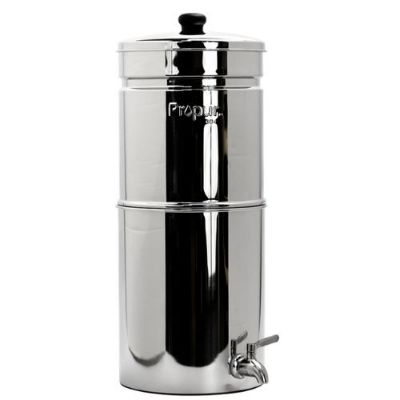
The ProOne Big+ is a gravity-fed stainless steel countertop water filter that’s a minimal-plastic alternative to most of the other water filters in this guide. It didn’t do as well as the other systems at reducing contaminants, and it isn’t performance certified, but it reduced 100% fluoride and (unlike the Waterdrop King Tank) doesn’t require a separate filter for this purpose.
Best For
Product Specs
| Price | 229.95+ |
| Contaminants Removed | 200+ |
| Certifications | NSF 42 (materials safety only) |
| Process | Ceramic + Carbon |
| Filtration Capacity | 1,000 – 1,200 gallons |
| Annual Cost | ~$100 |
| Warranty | 1 year |
What We Thought
The ProOne Big Plus has a unique performance benefit: it can be used to filter both treated city water and untreated surface water. In our testing, it did a good job of reducing contaminants in our city water and river water samples. It also received great scores for setup, design, company, and maintenance.
Unlike many of the other stainless steel countertop systems we tested, the Big+ has just one main filter that reduces all contaminants, including fluoride.
We were also pleased with the design quality of the unit – it felt sturdier and more durable than many of its competitors, and we appreciated the included stand and stainless steel spigot (other systems offer these at an extra cost).
ProOne Big+ Performance
The Big+ got an 8.44 score overall for contaminant reduction. As well as reducing 100% of fluoride, it eliminated lead, copper, aluminum, and manganese in our water. But it only reduced just 47% of total THMs and 56% chloroform, and it doesn’t have a performance certification, so its score wasn’t as high as others in this category.
The system redeemed itself in our untreated water test. We awarded it a 10.00 score because it eliminated all three bacteria types that our test water contained.
We had only positive things to say about the Big+ in the design category, and it got another 10.00 score from us. The filter elements have been NSF 42 certified for materials safety, and we noted that the unit’s stainless steel design felt sturdy and durable.
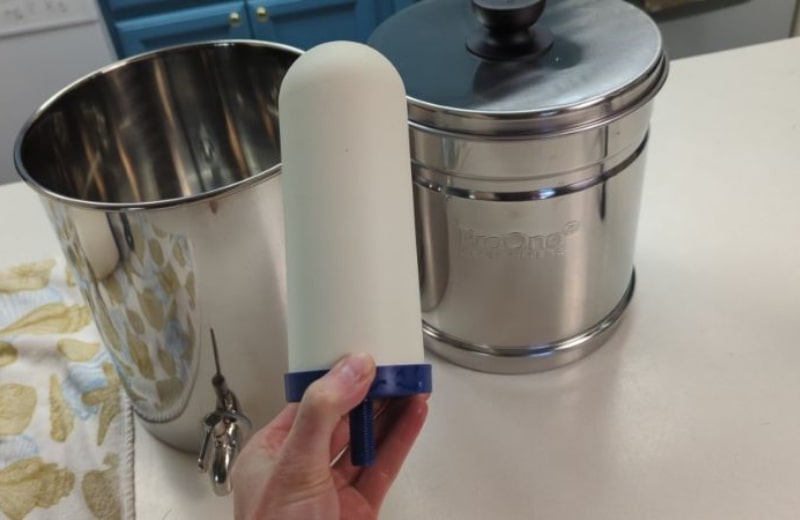
Setup was refreshingly easy compared to many other stainless steel units we tested. We just washed out the two chambers (which you may find tricky if you have a small sink), then scr\ubbed the filters with a scouring pad under running water. The whole process took less than 20 minutes thanks to the lack of filter priming required.
There were a few categories that the Big+ performed less impressively in. The filter’s $0.41/ gallon servicing cost was higher than most other fluoride filters we reviewed, and its 0.77 GPH filtration rate was slower than many similar systems, so it got a lower score of 7.00 here.
Because it can be used to filter untreated and treated water sources, we recommend the ProOne Big+ to anyone who wants an emergency preparedness system that they can safely use regardless of the quality of their incoming water supply.
| Criteria | Results |
|---|---|
| Health Related Contaminants | 8.71 |
| Aesthetic Related Contaminants | 9.9 |
| Performance Certification | Not certified for any reduction claims |
| Filtration Rate | 0.77 GPH |
| Component Quality | Exceptional |
| Component Certification | Exceptional |
| Setup | Good |
| Servicing Requirements | Good |
| Costs | $0.41/gallon |
| Warranty Length | 5 years |
| Shipping | Free shipping on orders over $69.95 to the lower 48 states |
| Returns | 30 days |


